Starting from Beijing, the capital of China, we can explore some ancient cities, such as Xi’an and other cities along the Yangtze River, including Chongqing and Yichang. As the longest river in China and the third in the world, the Yangtze River has a lot to offer. Sailing through the Yangtze River by taking the Three Gorges Cruise Tour, you can visit the Three Gorges Dam to feel its power and majesty. Our Yangtze River Cruise Tour with Suzhou offers you the best services and brings you a fresher feeling to China’s rich history and culture. In our 12-day China Tours including Yangtze River Cruise, you can explore many must-see tourist attractions that enable you to know more about China’s beauty and its long history behind. This is not only a scenic tour, but also a food tour, a cultural tour, and a leisure tour.

Upon your arrival in Beijing, your tour guide will wait for you at the airport with your name sign. Then you will be transferred to the hotel to check in. The rest of the time you are free to move around or take a rest at the hotel.
Our Yangtze River Cruise Tour will begin in Beijing, the capital of China. With a history of 3,000 years, Beijing is a famous historical and cultural city. Beijing covers an area of more than 16,000 square meters and has a permanent population of over 21 million. In addition, Beijing is China’s center in politics, culture, international communication, and science and technology. I’m sure that you will enjoy yourselves in Beijing.
After breakfast, you will explore one of the most famous squares in the world – Tian’anmen Square. Covering an area of nearly 440,000 square meters, Tian’anmen Square, serving as the heart of Beijing, enjoys a wide recognition at home and abroad. In China, Tian’anmen Square is the most important place for public activities. For example, the Founding Ceremony of the People’s Republic of China was held here on October 1, 1949.
Then you will enter the Forbidden City (closed each Monday), which is the typical Chinese architecture, and also the imperial palace for 24 emperors in the Ming (1368-1644) and Qing (1636-1912) Dynasties. During that period, ordinary people were not allowed to enter the imperial palace, which is the reason why it is called the “Forbidden City”. Among 24 emperors, Emperor Kangxi was the longest-serving emperor. There were tremendous changes in China’s society at that time during his 61-year reign. In his youth, he read widely and was a good tactician who had excellent natural military ability. At the beginning of his reign, the situation was extremely grim in China and the wider world. In this case, Emperor Kangxi resisted the invaders externally and realized the integrity and unity of the territory internally. Politically, he strengthened the centralization of power. On the other hand, he lessened people’s corvee and taxes and encouraged them to reclaim wasteland and grow crops. As a result, the area of cultivated land and the yield of crops increased rapidly, which fed a large population.
After lunch, you will visit the Temple of Heaven, a symbol of royal and divine power. The Temple of Heaven was first built in 1420 of the Ming Dynasty and was rebuilt in the Qing Dynasty. It is the place where the ancient emperors in the Ming and Qing Dynasties offered sacrifices to Heaven and prayed for a bumper grain harvest. Today, the Temple of Heaven is a place surrounded by greenery and beautiful flowers. Locals often go there to exercise or relax. Passing the park, you will see some people, young or old, do Tai Chi, a kind of Chinese traditional exercise. Nowadays, Tai Chi gains increasing popularity among foreigners. If you are interested, you can join them and learn some simple moves and kicks even on a zero basis. It is very helpful to your body and health.
After that, you will go to the Summer Palace, also known as the “Museum of Royal Gardens”. It is the place where most important historical events were held by the emperors of the late Qing Dynasty outside the Forbidden City. Here, the Long Corridor is a famous site that you cannot miss. It is said that Empress Dowager Cixi spent most of her late years in Summer Palace. One day, when Cixi wanted to take a walk in the Summer Palace as usual, it suddenly began to rain. To enjoy the view of the Summer Palace even on rainy days, Cixi immediately ordered the construction of a long corridor. The long corridor is 728 meters long and has more than 8,000 colored paintings, including landscapes, birds and flowers, human figures, and so on, all of which are originated from folk legends, traditional stories, and classical literature.


This morning, we will drive north and arrive at the Ming Tombs in about an hour. The place is around 50 kilometers away from Tian’anmen Square and covers an area of more than 120 square kilometers. The Ming Tombs, as the name suggests, are the tombs of the 13 emperors in the Ming Dynasty. It is also one of the largest and best-preserved imperial tombs in China.
As the first tomb of the Ming Tombs, the Chang Tomb is the largest in scale and the earliest in construction. It is a joint tomb of Emperor Zhu Di, the third emperor of the Ming Dynasty, and his empress. During his 22-year reign, Emperor Zhu Di began to find a burial site in 1407. In the Ming Dynasty, the emperors chose their burial sites, with a special emphasis on Feng Shui (geomancy). Therefore, Liao Junqing, a well-known Feng Shui master of the Ming Dynasty, was summoned by the emperor and went to Beijing in search of a place with good Feng Shui. According to Liao Junqing, there was a good place with good geomancy, called Loess Mountain. After hearing this, Emperor Zhu Di was very happy and renamed it Tianshou Mountain which means longevity in Chinese. In the eighth year of his reign, Emperor Zhu Di inquired about the progress of his tomb construction project. The minister told the emperor that the project was stopped. Emperor got very angry and asked the reasons. The minister said, “Liao Junqing played tricks on you, and the place he has chosen was damaged and the spring water overwhelms everywhere.” Liao Junqing replied that this was the location for the real dragon, and as soon as the emperor went there, the spring would stop. Emperor Zhu Di was surprised and went to Tianshou Mountain with the minister and Liao Junqing. But when Emperor Zhu Di got here, he saw that the spring water was still gushing. Emperor Zhu Di was furious and asked Liao why did it not stop. Liao answered unhurriedly that as long as he shouted a few incantations, the spring water would stop immediately. Then Liao Junqing shouted something strange to the sky and the spring water stopped gushing. The Emperor felt amazed and very happy. Since then, the Chang Tomb has been built there.
After lunch, we will drive you to the Great Wall in about an hour, 40 kilometers east of the Ming Tombs. As a famous tourist attraction both at home and the wider world, the Great Wall is a must-see site for visitors to China. It was a defensive military project in ancient China. Today we will take you to the Mutianyu Great Wall, one of the most representative sections of the Great Wall. It is also the longest section of the Great Wall in China. There’s a popular saying that goes: “You are not a true man until you reach the Great Wall”. Every tourist is eager to climb to the Great Wall. It is estimated, however, that it would take nearly 700 steps (about 50 floors high) to reach the top of the mountain where the Mutianyu Great Wall locates on foot. So, the climb would have been physically exhausting even for a young man. Therefore, we offer several ways to go up the mountain so that you can choose the way that suits you best. The first way is to go up and down the mountain by cable car. The cable car enables you to have a panoramic view of the Great Wall. And it is completely enclosed and safe, which is especially suitable for families with old people and children. The second way is to ride up and down by chairlift. It can also enable you to enjoy the beautiful scenery. But the chairlift is open-air, which requires people with more strength. The third way is to take the cable car up and the toboggan down. About one kilometer in length, the toboggan brings you excitement and fun.

 Xian
Xian After breakfast, you will be driven to the train station and take the estimated train G571 09:22/15:06 to Xi’an. Your tour guide will prepare you a lunch box containing fruit, cake, yogurt and so on. They are easy to eat without heating. As a metropolis, Xi’an is the capital of Shaanxi province, with a total area of more than 10,000 square kilometers and a permanent population of over 12 million. Xi’an, also known as Chang’an in ancient China, is one of the most important birthplaces of Chinese civilization and the Chinese nation, as well as the starting point of the Silk Road.
Upon your arrival, your tour guide will take you to the hotel and help you to check in. After that, you can have a rest at the hotel.
In the morning, we will drive about one hour to the Terracotta Warriors and Horses Museum, around 30 kilometers northeast away from downtown Xi’an. The terracotta warriors and horses of the Qin Dynasty (221-207BC), known as the “Eighth Wonder of the World”, demonstrate the wisdom and imagination of the ancient Chinese people. All the terracotta warriors show the faces and costumes of the Qin people, with distinct personalities and strong characteristics of that time. Covering an area of 16,300 square meters, the museum consists of 3 pits. In March 1974, villagers in the town of Mount Li, Lintong County, dug a well in the south of the village and discovered several broken, life-size terracotta figures. After excavation and exploration by archaeologists, Pit 1 of the terracotta warriors was unearthed. Serving as the largest one of the three pits, Pit 1 is 216 meters long, and 62 meters wide. It is estimated that there are 7,000 terracotta warriors, 100 chariots, and 100 horses in the three pits.
After lunch, you will go to the Big Wild Goose Pagoda. Located in the south of Xi’an, the Big Wild Goose Pagoda is the earliest and largest brick pagoda of the Tang Dynasty in the style of the Sifang Pavilion. This famous pagoda is also a typical architecture of the fusion of Indian pagodas and the Chinese culture, embodying the wisdom of the ancient Chinese. In 652 of the Tang Dynasty (618-907), Master Monk Xuanzang returned from Tenjiku with statues of Buddha, relics, and Sanskrit Buddhist classics. And he was responsible for the building of the Big Wild Goose Pagoda to have a place for Buddhist books.
After that, you will visit the City Wall, the largest and best-preserved ancient city wall in China. At the City Wall, you can choose to take a walk or rent a bike. It’s exciting and interesting to ride around the City Wall and bicycles can be returned at the nearest gate. After dark, the ancient City Wall with lights on is very gorgeous. Here, you can not only enjoy a rich sense of the history of ancient China but also take beautiful photos to post on your Instagram.
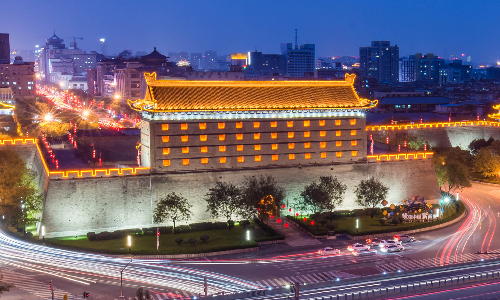
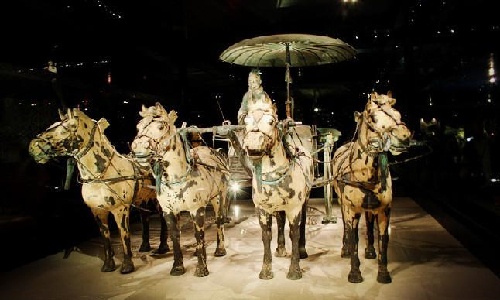
 Chongqing
Chongqing This morning, after breakfast, you will be transferred to the train station and take the estimated train D1971 09:05/13:42 to Chongqing. As a famous city in southwestern China, located on the upper reaches of the Yangtze River, Chongqing is steeped in a long history and culture. It covers an area of 82,400 square kilometers and has a permanent population of more than 30 million. The landform of Chongqing is mainly comprised of hills and mountains, of which the mountainous area accounts for 76%. Therefore, the city is also known as “Mountain City”. As part of the Yangtze River, the Three Gorges in Chongqing are famous for their charming landscapes. Our Yangtze River Cruise Tour will let you enjoy the breathtaking scenery and experience the rich history and amazing culture in China.
We will prepare you a meal box for your lunch. Upon your arrival in Chongqing, your local tour guide will take you to the Ciqikou Ancient Town, where you can enjoy the beauty and charm of the ancient city of Chongqing. You can also enjoy a variety of traditional snacks, and watch traditional performances such as Sugar Figure Blowing Art and Sichuan Opera Face-Changing Show.
After that, you will head to the Chaotianmen Pier and take the Three Gorges cruise ship. Your tour guide will get off the cruise ship after completing the formalities for you. Please keep in mind that the cruise ship stops boarding at 20:30, and departs at 21:00. The Three Gorges cruise ship is well-equipped to provide passengers with a strong sense of comfort. Each room onboard is well-equipped with WIFI, an air-conditioner, and a separate bathroom. Most of the rooms have balconies that enable you to have a broad view of the Yangtze River. On the cruise ship, bar, café, library, gym, and beauty salon are open to everyone. And the service staffs onboard are well-trained, considerate, and experienced. I’m sure that they will bring you the best service and care. This will make you feel relaxed and happy during your Yangtze River Cruise Tour.


In the morning, you can sleep until naturally wake up and then enjoy a buffet breakfast. After that, you can participate in a wide variety of activities onboard, such as Tai Chi and Yoga. You can also stand on the deck to relax, enjoy the beautiful scenery of the Yangtze River.
Today, you’ll have a shore excursion and go to see the Shibaozhai Pagoda. The place has been listed as one of the eight most marvelous buildings in the world. Looking down from the highest point of the Shibaozhai Pagoda, you can enjoy the endless scenery of the Yangtze River.
After that, you will go to the Fengdu “Ghost City” (with an extra charge). This is a voluntary travel project on the ship. You can pay for it on the ship. If you opt not to go to the optional tourist attraction, you are free to stay on the ship and move about. With a history of nearly 2,000 years, the place is a must-see cultural landscape for tourists. The Fengdu “Ghost City” looks like a netherworld, a world that is simply a figment of people’s imagination and creativity. Fengdu “Ghost City” is famous for its rich ghost culture both at home and abroad. The various images of ghosts here are vivid and quaint.
In the evening, there’s a captain’s welcome reception. At the reception, the captain will lead the ship’s officers and staff to meet with everyone and give a welcome speech. After that, the staff will bring wonderful performances, and you can join in the dance.
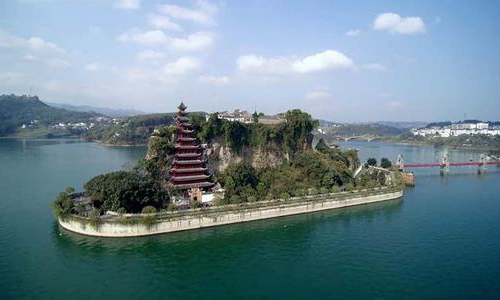

In the morning, you can enjoy your self-help breakfast and do morning exercise of Tai Chi. Today is the highlight of our journey! The cruise ship will pass the Three Gorges, namely Qutang Gorge, Wu Gorge, and Xiling Gorge. On the cruise ship, you can relax and have a panoramic view of the Yangtze River. Qutang Gorge, around 8 kilometers long, is the shortest of the Three Gorges. Here the mountains are high and steep while the river is narrow and fast flowing. When you come here, you will be astounded by its beauty and magnificence.
At Qutang Gorge, we have an additional shore excursion to visit the White Emperor City. This is also a voluntary travel project on the ship. Previously named Ziyang City, the White Emperor City was built by Gongsun Shu, alias Gongsun Ziyang, at the end of the western Han Dynasty (202 BC-8 AD). In 25 AD, Gongsun Shu proclaimed himself emperor and claimed to be White Emperor. Since then, Ziyang City was renamed the White Emperor City.
Then you will go to the Wu Gorge. At Wu Gorge, you will disembark the ship and board a smaller boat to visit the Goddess Stream. It is also called “Beauty Stream” by locals for its majestic scene. Finally, you will go to the Xiling Gorge. The 45-kilometer-long gorge is the starting point of the Yangtze River, as well as the longest and most precipitous gorge among the Three Gorges. Along the way, you can enjoy the picturesque landscape on both sides of the Yangtze River.
In the evening, you will have a captain’s farewell banquet. First of all, the captain will make a short speech, and then the guests can enjoy a fancy dinner. When you enjoy your dinner, you can watch the wonderful performances brought by the staff on the ship, such as Sichuan Opera face-changing show, folk dance, traditional Chinese lion dancing, magic show, and so on. After that, the performers will invite guests to have an interactive show. And at the end of the show, everyone will dance together and have a good night.
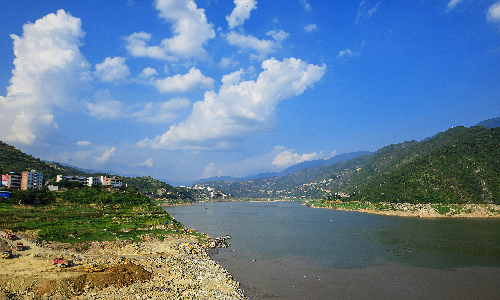

 Shanghai
Shanghai After breakfast, you will go to the Three Gorges Dam Site. With a total length of around 3,335 meters, the dam is the world’s largest hydropower project and a multipurpose water conservancy complex. It owns many important functions in flood control, shipping, power generation, aquaculture, tourism, irrigation, and so on. You can feel its power and majesty. Then you will have an additional shore excursion, that is to board sightseeing-ferry sailing through TGP Ship’s elevator. This is a self-paid item recommended and arranged by the ship. Later, you will be driven to the Yichang Three Gorges Center Cruise Terminal. And your tour guide will go with you to the Yichang Railway Station and you will head to Shanghai by taking the estimated train D354 14:46/22:21.
Upon your arrival in Shanghai, your local tour guide will pick you up at the train station and drive you to the hotel to check in. Then you can have a nice rest at the hotel and expect a wonderful exploration of the modern city of China tomorrow. Shanghai, lying at the mouth of the Yangtze River, is also a must-go place during our Yangtze River Cruise Tour. As a world-known metropolis city, Shanghai is 6,340 square kilometers in total area and has a permanent population of 24.87 million.
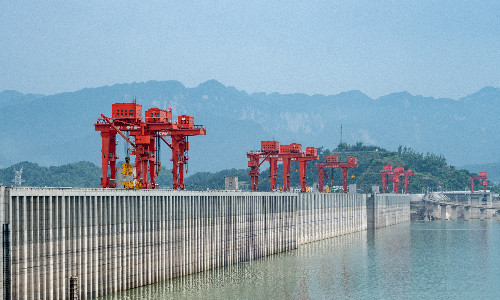
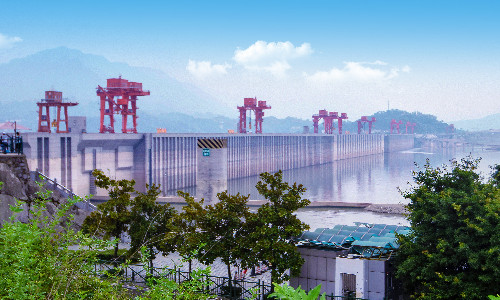
In the morning, we will begin our journey to the Yu Garden (closed each Monday). Built in the Ming Dynasty, the Yu Garden is a famous classic garden, dating back over 400 years. It was originally a private garden that belongs to Pan Yunduan, who spent more than 20 years of painstaking work on this garden. The “Yu” - means peace and well-being in Chinese. It is said that in the 38th year of Jiajing (1559), Pan Yunduan failed his imperial examination, and that’s when he came up with the idea of building a garden. During the construction period, Pan Yunduan became an official and had no time to spare for his garden. Until 1577, he returned to his hometown, focused on the building of the garden, and hired the famous horticulturist Zhang Nanyang as the designer. After that, Yu Garden became bigger and bigger and coverd an area of around 12 acres. However, due to the tremendous cost of maintaining the garden and the decline of the Pan family, the Yu Garden had fallen into decay. During the reign of Emperor Qianlong (1736-1796), some wealthy men raised funds and restored the original landscape of the Yu Garden. Since then Yu Garden is no longer a private garden, but a gathering place for the gentry.
After that, you will go to Shanghai Old Street, a multi-functional street that is a mixture of sightseeing, shopping, leisure, and cultural display. Here you can enjoy the traditional folk culture of old Shanghai and feel its rich history and culture. You can buy some special souvenirs for your family and friends, such as silk products and fans. You can also enjoy some delicious local food, such as soup dumplings, and sweet green rice ball.
In the afternoon, you will visit the Shanghai Tower, a high-rise landmark skyscraper in Shanghai. It covers a total floor area of 578,000 square meters, and has a total height of 632 meters, with 127 storeys above ground and 5 storeys below. Standing on the sightseeing observation deck, you can have a panoramic view of Shanghai, including the Oriental Pearl Tower and Shanghai World Financial Center, and feel the development of the city. Another feature of the building is the high-speed elevators. The high-speed elevators reach a maximum speed of more than 64 kilometers per hour, making them the fastest elevators in the world. By taking the high-speed elevator, you can get to the 118th floor in one minute, because the elevator can reach 18 meters per second.
After that, you will go to Nanjing Road, which is regarded as the first commercial street in Shanghai and is now also one of the top 10 commercial centers in Shanghai. Blending tradition and modernity, the century-old street is prospering with frequent business and trade activities. It is surely a paradise for shoppers both at home and abroad. So, it is also a paradise for food lovers.
Then you will go to the Bund, one of the most well-known symbols of Shanghai. Spanning about 1.5 kilometers, the Bund is China’s historical and cultural area situated on the bank of the Huangpu River. On the Bund, there are 52 classic buildings of different styles, serving as the landmark of Shanghai. No.2 on the Bund was the site of the former Shanghai Club, which was founded in 1861. When the building was completed in 1991, it provided a recreation area for English gentlemen. Many important affairs of the Shanghai International Settlement were discussed here. A century later in 2011, the building underwent a renovation that made it prosperous and luxurious.
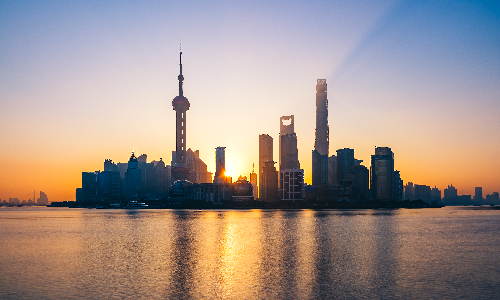

After breakfast, you will go to the Shanghai Museum (closed each Monday). Built in 1952, it covers an area of 11,000 square meters. The museum has 11 special halls, with a display area of 2,800 square meters. The Shanghai Museum has a collection of nearly 1 million cultural relics, of which bronzes, calligraphy, paintings, and chinawares are the most distinctive. One of the most valuable items is dichondra. It is a golden coin with a diameter of 5.6 cm and a height of 2.8 cm, dating back from the Western Han Dynasty.
Then you will visit the Jade Buddha Temple. Built in the reign of Emperor Guangxu of the Qing Dynasty, the Jade Buddha Temple is a building modeled after the imperial palace of the Song Dynasty (960-1279). It is said that during the Guangxu period, the famous monk Huigen brought back five jade Buddhas from Myanmar. Passing by Shanghai on his way home, he left two statues of Sakyamuni carved in white jade. And he raised money to build the Jade Buddha Temple in order to dedicate them to Shanghai.
In the afternoon, you will go to the Zhujiajiao Ancient Water Town, around 50 kilometers away from the center of Shanghai. Located in the western part of Shanghai, the place is about an hour’s drive from downtown. As a typical southern water town, Zhujiajiao Ancient Water Town boasts a developed economy and enjoys a superb natural environment. You will have some free time to walk around. After enjoying the beautiful water town, you will be transferred to your hotel and have a good rest.
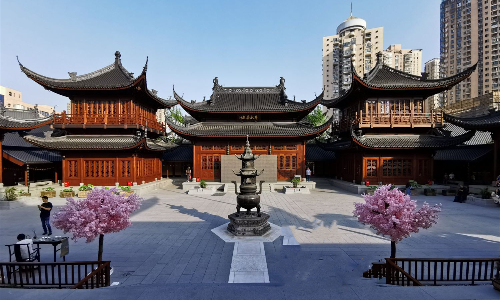
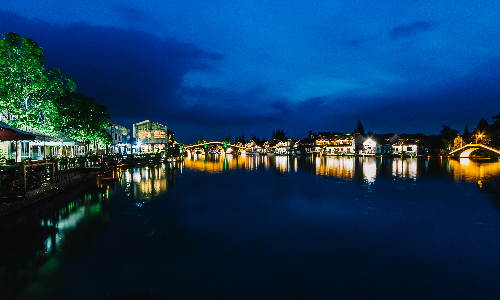
Today your 12-day Yangtze River Cruise Tour with Suzhou will come to an end after breakfast. Your tour guide will help you check-out and accompany you to the airport. Hope you have a pleasant journey!
Author: Wang Zihan
Proofreader: Lexie
| City | Five Star hotel list | Four Star hotel list |
|---|---|---|
| Beijing | Sunworld Dynasty Hotel Beijing Wangfujing | Sunworld Hotel Wangfujing |
| Xi'an | Tianyu Gloria Grand Hotel Xi'an | Sunworld Dynasty Hotel |
| Yangtze River Cruise | Victoria Anna | Victoria Anna |
| Shanghai | Ocean Hotel Shanghai | Courtyard by Marriott Shanghai Central |
 |
![]() About your child or infant, please contact us for a discounted price.
About your child or infant, please contact us for a discounted price.



We started with a few days in Beijing & ended in Shanghai, from where we visited the Forbidden City and Great Wall. In between we visited Terra Cotta Warriors Museum, Panda Base, Shanghai Disneyland.

We had a wonderful holiday in China which will remain long in the memory. China is a breathtakingly beautiful country full of splendid temples and palaces, mountains and rivers, peaceful rural scenes and bustling shopping streets.
 QUICK ENQUIRY
QUICK ENQUIRY